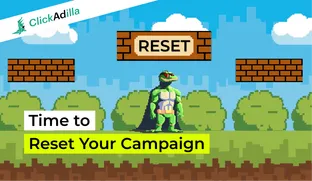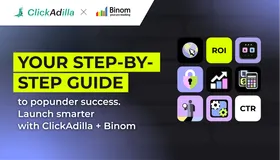
In this article, we prepared a comprehensive remedy guide designed to help you understand the reasons behind your campaign's lack of traction and provide actionable solutions to get it back on track.
So, your campaign isn't getting any traffic?
First, take a deep breath and relax. The silver lining here is that since your campaign isn’t attracting visitors, you’re not spending your budget. This gives you the opportunity to pause, reassess, and address the issue without financial pressure.
Remember, identifying the problem is the first step toward a successful campaign. Stay calm and methodically work through this guide to turn things around and achieve your campaign goals.
So, let’s begin with some potential reasons your campaign might not be performing as expected.
- Too Narrow Targeting - While precise targeting can help reach your ideal audience, it can also severely limit the number of people who see your ads. For instance, when your campaign targets a very specific demographic, such as women in San Francisco who are interested in high-intensity interval training (HIIT) and have recently bought fitness gear online, it can lead to significant limitations. While this approach aims for precision, it also drastically reduces your potential audience size, resulting in you missing opportunities to engage with broader segments of fitness enthusiasts who are interested in related activities or products but don't fit all these narrow criteria.
- Mixing the GEO names - for example, you want to target users from India (IN), who speak Hindi. Mistakenly, you picked the right GEO but set the user language to ID – Indonesia. The poor system will struggle to find Indonesian speakers in India but will fail.
- Forgetting to press the Launch button - Yes, it’s funny, but we can all become THAT busy or tired.
- Adding the wrong offer link - A technical mistake: you wanted to send traffic to a Social app but added a landing page link for an iGaming site. Your tracker will, of course, show zero traffic for the social app, but you will soon find it all on the iGaming one.
- Wrong targeting combos - for instance, targeting Safari on an Android-only campaign will barely bring you any users.
- Wrong Whitelist settings - sometimes, advertisers whitelist the zones from a different format. For example, you whitelisted zones from a push campaign and now want to target these zones using another format.
Resetting a campaign is a critical practice in digital marketing for several compelling reasons.
- Firstly, it provides a necessary checkpoint to evaluate the current performance objectively.
- Secondly, market dynamics and consumer behavior evolve over time. Resetting allows you to realign your campaign strategies with these changes, ensuring your messaging remains relevant and impactful.
- Additionally, budget optimization becomes possible through a reset, enabling you to reallocate resources to channels or tactics that demonstrate better performance.
- Creative refresh is another benefit, as resetting allows for the introduction of new ad creatives, testing of different messaging, or experimenting with innovative formats to re-engage your audience.
- Lastly, it facilitates the testing of new strategies and tactics that could potentially unlock untapped opportunities.
Hence, resetting a campaign is not just about starting over; it's a strategic process aimed at improving overall performance metrics and aligning marketing efforts with business goals effectively.
Reviewing Campaign Goals
When you reset an ad campaign, it’s crucial to start by reassessing your campaign goals. This review process helps you determine whether your initial objectives are still relevant and achievable given any new market conditions or insights gained from previous campaigns because it allows you to refine your goals to better reflect your current business needs and marketing environment.
Setting Realistic and Measurable Goals
During the reset, take the opportunity to set realistic and measurable goals. If your previous campaign had goals that were too ambitious or vague, this is the time to adjust them. For example, if your original goal was to "increase brand awareness," refine it to "achieve a 15% increase in brand recall within the next three months."
Realistic goals ensure that your campaign efforts are achievable, while measurable goals allow you to track progress and make data-driven adjustments along the way.
Aligning Campaign Objectives with Target Audience
Also, resetting your campaign involves realigning your objectives with the interests and needs of your target audience. Market conditions and consumer behaviors can change, so it's vital to ensure that your campaign messaging and strategies are still relevant.
For instance, if your target audience has shown a growing interest in sustainability, your campaign should emphasize how your product or service contributes to eco-friendly practices. By resetting your campaign with a fresh understanding of your audience, you enhance the likelihood of engaging them effectively and driving conversions.
Audience Targeting and Segmentation
Precise audience targeting is fundamental to the success of any advertising campaign. By clearly defining and reaching the right audience, you ensure that your marketing messages resonate with people who are most likely to be interested in your product or service. This not only increases the efficiency of your marketing spend but also improves engagement rates, conversion rates, and overall return on investment (ROI). When you target the right audience, you can tailor your messaging to address their specific needs, preferences, and pain points, which enhances the relevance and impact of your ads.
Techniques for Effective Segmentation
Keep your segments more widely defined
Although the point of audience segmentation is to aim for specificity, it’s possible to segment your audience too narrowly. If your market is too narrow that it barely contains anyone, that’s a problem. You’ll either reach too few people, or you’ll end up spending time and energy writing messages for too many different audiences.
Focus on a few groups, but keep those groups broad enough to encompass relatively wide swaths of your customer base. Instead of “middle-aged customers that buy at Christmastime, pay with Discover, and live in Minnesota,” try defining your audience as “Midwestern customers that make more purchases during the holidays.” The latter audience segment allows for much more wiggle room.
Aim for constant improvement
If the combination of audience segmentation tools you used didn’t work, experiment with another mix until you find the most effective way to reach your potential customers and existing audience. Measure the data to see where people are landing on your site, how long they’re staying, and what’s making them leave. Then incorporate that data into your next effort and into the day-to-day operations of your marketing.
Use different channels
While driving traffic from ad networks is the best option, there are more channels you can explore when it comes to building better relationships whith your audience depending on the vertical.
How to set targets at ClickAdilla personal account
Now that you’ve got the basic audience segmentation definition down, you might be wondering how you can set targets at ClickAdilla for audience segmentation. It is easy to set your target at ClickAdilla, just
- Log in to your personal account
- Create a campaign or edit an existing one,
- If you edited an existing campaign, you can directly go to the “targeting” section.
ClickAdilla allows you to create simple segments if you’re a beginner, or you can create more complex segments with more specific parameters. More complex audience segments can allow you to further target your audience in unique and engaging ways with content they're actually interested in.
Optimizing Ad Creatives
A/B testing, also known as split testing, is a method used to compare two or more versions of an ad to determine which one performs better, it plays a crucial role when you are resetting your ad campaign. It provides actionable insights into what works best, reduces financial risk, enhances user experience, and allows for quick adaptation to market changes. When doing an A/B test you can:
- Experiment with different headlines to find the most attention-grabbing.
- Test various visuals to see which resonates best with the audience.
- Try different calls-to-action to identify the most compelling.
- Vary the copy to discover the most persuasive messaging.
- Assess different designs and layouts to optimize visual appeal.
Budget and Bidding Strategies
When doing a budget allocation consider how you want your budget distributed across campaigns and ad groups. A budget bid strategy will help you with it, because it automatically optimizes spending toward the key metrics you have chosen for a plan. For example, if your key metric is clicks, then your budget bid strategy automatically optimizes spend to get the most clicks at the lowest average cost per click given the amount you want to spend over the date range of the plan.
Remember, each bid strategy is suited for different kinds of campaigns and advertising goals. For the purposes of bidding, you'll want to consider five basic types of goals, along with your current campaign settings.
- If you want customers to take a direct action on your site, and you're using conversion tracking, then it may be best to focus on conversions.
- If you want to generate traffic to your website, focusing on clicks could be ideal for you. Cost-per-click (CPC) bidding may be right for your campaign.
- If you want to increase brand awareness, focusing on impressions may be your strategy. You can use cost-per-thousand viewable impressions (vCPM) bidding to put your message in front of customers.
- If you run video ads and want to increase views or interactions with your ads, you can use cost-per-view (CPV) or cost-per-thousand impressions (CPM) bidding.
- If you run video ads and your goal is to increase product or brand consideration you can use cost per view (CPV).
How to enable auto adjust at ClickAdilla?
- Go to dashboard section in a tab on the left in your ClickAdilla account;
- Choose a campaign that you created before;
- Press the adjust button;

If you want your price to be adjusted automatically in the future - make sure that the function is enabled. After changing the limits for your price range and maximum price please save the parameters.
Choosing the Right Traffic Sources
How to choose the right traffic source for your campaign? Well, in ClickAdilla we have what you call whitelist and blacklist. What are these? Advertisers use the Whitelist to indicate the list of sites they have chosen to serve ads. Blacklists are lists of sites on which ads, on the contrary, will not be shown. What's the point? Obviously to increase the performance of the advertisement. Advertisers add to the blacklists sites with low-quality bot traffic, non-target audience and high bounce rate.
How to add whitelists and blacklists at ClickAdila?
- You can edit your Blacklist and Whitelist while creating campaigns or when you edit your existing campaign.
- Use tokens to collect statistics about visitors. You can find tokens here.
- You can always ask our support manager to check the correctness of your link.
- If you find rich sources with a steady stream of conversions, then add them to the whitelist.
- You will need more time to collect relevant statistics testing new offers.
If the advertisement is ready, then activate the campaign and get at least several thousand impressions or a hundred clicks to obtain sufficient data to determine the effectiveness of the sources.
Note: Whitelists and blacklists can't be used in one campaign at once.
Monitoring and Analytics
When you want to monitor your traffic, the first step is to decide which metrics you should track and why. Metrics are quantitative indicators that show website performance. Visits, unique visitors, pageviews, bounce rate, average time on page, pages per visit, and conversion rate are all popular metrics that you can use. It is important to select metrics that align with your goals and objectives and help you answer questions about your traffic.
For instance, if you want to know how engaging your content is, look at bounce rate, average time on page, and pages per visit. If you are trying to evaluate the effectiveness of marketing campaigns, examine visits, unique visitors, and conversion rates.
ClickAdilla has a different tracker to help you monitor your campaign, you can use it by
Step #1 - Create your postback URL
Step #2 - Add Clickadilla as your traffic source on any tracker you choose
Step #3 - Generate the postback URL
Step #4 - Set up the Campaign on any tracker you choose
Step #5 - Set up the Campaign on Clickadilla
Step #1 - Create your postback URL
- Log in to your ClickAdilla Advertiser Account, click the Tracking tab.
- Your Clickadilla postback URL is created automatically.
Note: You will need your unique token in Step #2.
Step #2 - Add Clickadilla as your traffic source on on any tracker you choose
- Log in to the account of any tracker you choose.
- Choose the Traffic sources tab and then click the New from templates button.
- Then, find and select Clickadilla from Traffic source templates.
Note: Don’t forget to change “REPLACE” to your unique token from postback URL that we created in Step #1.
After completing all replacements, click Save to store your Clickadilla settings (if you want to make any changes - select your traffic source from the list and click Edit button).
Step #3 - Set up the Campaign on Clickadilla
Log in to your ClickAdilla advertiser account and create your Ad and Campaign. This video will help you to create a campaign easily and quickly.
Conclusion
In this guide, we covered the key steps to reset and optimize your ad campaign. We addressed identifying issues like narrow targeting and incorrect settings, reassessing and refining goals, and broadening audience segments. We emphasized the importance of A/B testing for ad optimization, efficient budget allocation, and choosing the right traffic sources. Monitoring key metrics to make data-driven decisions was also highlighted. Now that you have a clear understanding of how to diagnose issues and reset your campaign effectively, it's time to put this knowledge into action. Don’t let a slow start discourage you. Take this opportunity to reset, optimize, and revitalize your campaign.
If you’re new to ClickAdilla or haven’t yet leveraged its robust tools, now is the perfect time to join. ClickAdilla offers comprehensive features for campaign management, targeting, and analytics that can help you achieve your marketing goals more effectively.
Q&A
Q: How do I know if my targeting is too narrow?
A: If your campaign isn’t getting enough impressions or clicks, consider broadening your targeting criteria. Start by widening demographic parameters or expanding geographic regions.
Q: What should I do if I accidentally set the wrong geographic settings?
A: Correct the settings immediately. Double-check to ensure the targeted language and region match your desired audience.
Q: How often should I reset my campaign?
A: Regularly review your campaign performance. Resetting should be considered when significant changes in market conditions occur, or if you notice a decline in performance metrics.
Q: What is A/B testing, and why is it important?
A: A/B testing involves comparing two or more versions of an ad to determine which performs better. It’s crucial for identifying the most effective elements of your ads and improving overall campaign performance.
Q: How can I optimize my budget for better performance?
A: Use a budget bid strategy that aligns with your key metrics. For instance, focus on conversions if your goal is to drive actions, or clicks if you aim to generate traffic.
Q: What metrics should I track to monitor my campaign effectively?
A: Key metrics include visits, unique visitors, pageviews, bounce rate, average time on page, pages per visit, and conversion rate. Choose metrics that align with your campaign goals.





